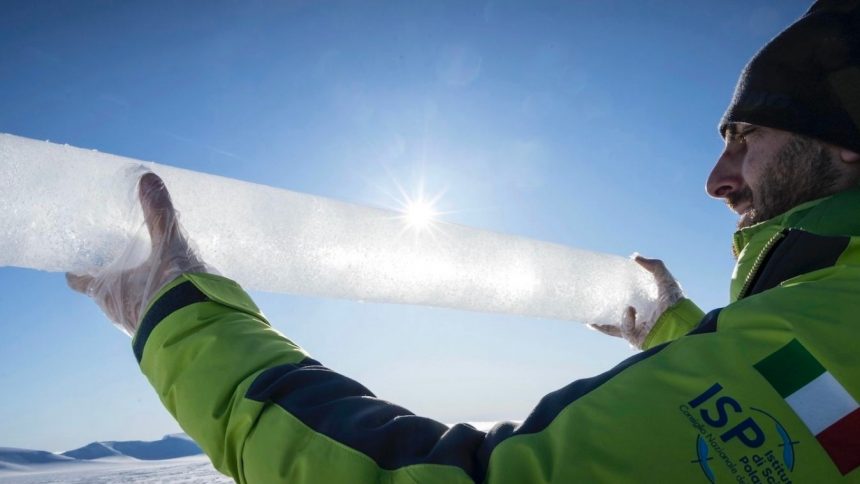This story was originally published by Yale Environment 360 and is reproduced here as part of the Climate Desk collaboration. When Margit Schwikowski helicoptered up to Switzerland’s Corbassière glacier in 2020, it was clear that things weren’t right. “It was very warm. I mean, we were at 4,100 meters and it should be sub-zero temperatures,” she says. Instead, the team started to sweat as they lugged their ice core drill around, and the snow was sticky. “I thought, ‘This has never happened before.’” What Schwikowski couldn’t see yet, but would find later in the lab, is that it wasn’t just the surface that was affected: Climate change had penetrated the ice and trashed its utility as an environmental record. Warming weather had created meltwater that trickled down, washing away trapped aerosols that researchers like her use as a historical record of forest fires and other environmental events. Because of the melt, she says, “we really lose this information.”
Schwikowski, an environmental chemist at the Paul Scherrer Institut near Zurich, is the scientific lead for the Ice Memory Foundation, a collaborative group that aims to preserve glacial ice records before climate change wrecks them. Their goal is to get cores from 20 glaciers around the world in 20 years and, starting in 2025, lock them away for long-term storage in an ice cave in the Antarctic — a natural freezer that will hold them at close to minus 60 degrees F (minus 50 degrees C). Since the program’s start in 2015 they have taken cores from eight sites, in France, Bolivia, Switzerland, Russia, Norway, and Italy. But the core attempted from Corbassière was a failure — and has the team wondering if they are already too late.
The team, watching in despair as ice cores melt and muddle, is not alone in seeing climate change wreaking havoc with scientific records — often in unexpected ways. Geologists who hunt for meteorites on the ice in Antarctica are finding their mission thwarted by warming temperatures. And while archaeologists who study the artifacts spat out by ice patches are seeing a bonanza of new finds, they are also racing to get to those objects before they rot. Other heritage sites are slumping into thawing permafrost. What all these researchers have in common is a race to preserve what they can, while they can. When you are standing on a glacier that’s literally melting under your feet, says Schwikowski, “you really feel the urgency.”
Researchers extract an ice core on an Ice Memory Foundation expedition to the Colle del Lys glacier in the Alps, October 2023. Riccardo Selvatico / CNR / Ice Memory Foundation
Due to climate change, high mountain glaciers are now endangered, losing ice faster than they are gaining it. Studies of a few dozen well-monitored glaciers in the World Glacier Inventory have shown that the pace of glacial ice loss has accelerated from a few inches per year in the 1980s to nearly 3 feet per year in the 2010s. A 2023 model of some 215,000 mountain glaciers showed that nearly half of them could disappear entirely by 2100 if the world warms by just 1.5 degrees Celsius (2.7 degrees Fahrenheit), the ambitious maximum warming target of the Paris Agreement.
Glaciers have annual layers, just like tree rings. At the top, a single year might see a few feet of snow added to the surface. Hundreds of feet down, weight compresses ice that is thousands of years old into thin, flowing layers, where less than an inch may contain a century of snowfall. This ice preserves all kinds of information from the time when it was deposited. A spike in lead pollution comes at the height of the Roman Empire. A drop in pollen reveals the collapse of farming during the Black Death. The Chernobyl accident left a layer of radioactive cesium. Black carbon and the sugars from burned cellulose map out changes in forest fire activity across the globe. The ratio of different oxygen and hydrogen isotopes in the water also reveals the air temperature of the time.
Many mountain glaciers have been cored and studied over the past decades. Since scientific methods and research questions change over time, researchers preserve some cores or sections intact for future reference — to study, say, the genetics of ancient DNA. The National Science Foundation Ice Core Facility in Colorado, for example, holds 82,000 feet of collected ice cores — mostly from Greenland and the Antarctic, but also from North American mountaintop glaciers. The problem of glacial ice melting has been apparent for many years, says paleoclimatologist Ellen Mosley-Thompson of Ohio State University. In 2000, when she and her colleagues drilled to bedrock on Mount Kilimanjaro, they found the surface dated to the 1950s. The top 50 years of snow was gone. “Everyone in our community is worried,” she says.
Read Next
What your gut has in common with Arctic permafrost, and why it’s a troubling sign for climate change
Dorothea Moser, a PhD student who works on the ice core chemistry team at the British Antarctic Survey, says she has seen cores damaged by melt even in polar regions, including Greenland and coastal Antarctica. “I’ve got records from Young Island [in the Southern Ocean] that have been heavily melt affected,” she says. She is now working to see what kinds of information can still be salvaged from corrupted cores. Moser warns that ice cores are highly vulnerable to increased melting through global warming. “This is why we need to retrieve them, where possible,” she says.
In 2015, glaciologist Jérôme Chappellaz of the Swiss Federal Institute of Technology and chemist Carlo Barbante of the University of Venice established the Ice Memory Foundation to capture archival cores from endangered mountain glaciers. “Ice Memory is attempting to answer the call of these glaciers before they disappear,” says Mosley-Thompson, who is not a member of the foundation. Fewer than a dozen teams around the world do coring work in high mountain settings, says Schwikowski — it takes skill and determination to haul the equipment up to these remote locations, she says, often in collaboration with mountaineers. Progress has been slow. And, just halfway into their collection effort, the work at Corbassière has shown it may already be too late to get pristine records from some sites.
The team only retrieved around 60 feet of core from Corbassière, rather than the 260 feet down to bedrock that they had hoped for, because the drill got stuck in melted-and-refrozen ice. And a comparison of this truncated 2020 core with a 2018 sample from the same spot showed that the record was corrupted. While the temperature record was preserved, the spikes of nitrate, sulfate, and ammonia they had seen in the 2018 core had, by 2020, washed away. The team thinks the cumulative effect of meltwater is to blame. Deeper ice may or may not be damaged, too.
Margit Schwikowski holds an ice core from the Corbassière glacier in the Alps, September 2020. Scanderbeg Sauer Photography
The team has no idea how many other glaciers are affected: A core that the group took more recently from Svalbard in Norway was similarly muddled, says Schwikowski, while one taken from Monte Rosa in the Alps in 2021 seems to be intact. “I am afraid that most of them are already affected,” she says. “We will see what we can do.” The loss of paleorecords in glacial ice is also distressing to archaeologists, who use those signals to help unravel the behaviors of past societies and the environmental conditions they faced.
Of course, archaeologists also have another category of study material: human artifacts. To find these, they often look to ice patches — wind-blown snow drift accumulations that can be thousands of years old. Christian Thomas, an archaeologist with the Yukon Territory’s Department of Tourism and Culture, says such patches typically overlap with traditional summer hunting grounds, so ancient weapons are often found there. The first documented find from an ice patch was an arrow in Norway during a particularly warm year in 1914. Discoveries were only random and occasional until the 1990s, when such finds sped up along with the rate of ice melt, says Lars Holger Pilø, co-director of the Secrets of the Ice program at Norway’s Department of Cultural Heritage. “We had no idea how intense the human use of the high mountains had been until all these artifacts started to emerge from the retreating ice,” he says. “In that way, we are unlikely beneficiaries of global warming.”
Since Pilø started his own work…






